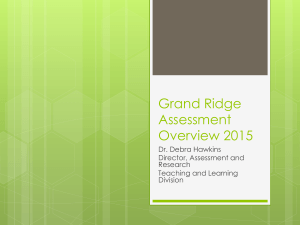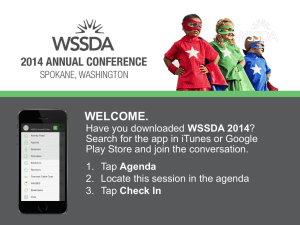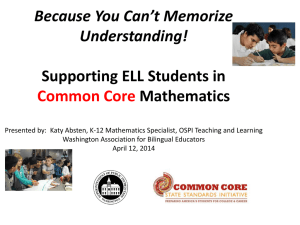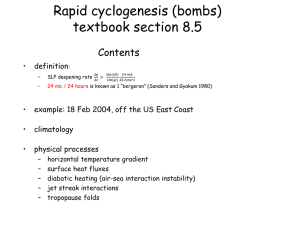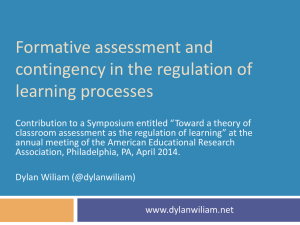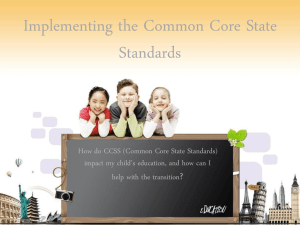Common Core Instruction and Special Education
advertisement
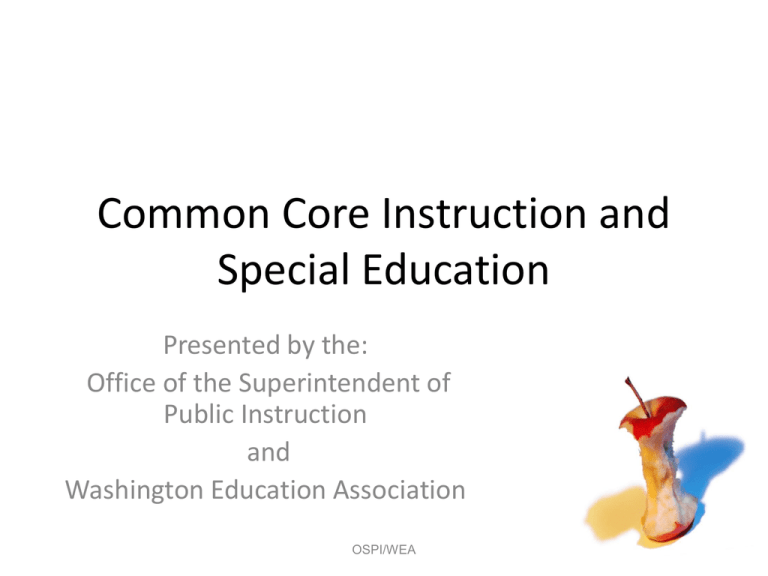
Common Core Instruction and Special Education Presented by the: Office of the Superintendent of Public Instruction and Washington Education Association OSPI/WEA 1 Goals Participants will: • understand the standards. • be able to unpack the standards and identify the elements within the standards. • identify opportunities to enable the student to move through the general education curriculum and/or the Common Core State Standards. • will learn the principles of formative assessment and its use in monitoring student progress. OSPI/WEA 2 You need to remember • CCSS not a packaged curriculum • CCSS are not appropriate goals for IEP • Special ed rules unchanged • IEP based on evaluation OSPI/WEA 3 Prior Knowledge What do you know about? • The Common Core Standards • Special Education • How the Common Core Standards/District Curriculum and Special Education Intersect? OSPI/WEA 4 Common Core Standards Definition of standards Provide a consistent, clear understanding of what students are expected to learn… reflecting the knowledge and skills that all young people need for success in college and careers (ACHIEVE- common core website) OSPI/WEA 5 How does Instruction relate to the Common Core Standards? “WHAT” students learn. “HOW” we teach. Common Core State Standards Instructional Strategies OSPI/WEA 6 How do the Common Core Standards differ from old standards In the past: Currently: • Student Learning Objectives • Essential Academic Learning Requirements • Grade Level Equivalency • Performance Expectations • Common Core OSPI/WEA 7 Knowledge, Skills and Abilities The Common Core State Standards are statements of what students should know and be able to do. • CCSS are Academic Achievement Standards – Developed by content areas and organized by grade with increasing complexity • CCSS Standards apply to all students, including students with disabilities OSPI/WEA 8 Curriculum Common Core State Standards IEP Goals ONE WAY OSPI/WEA 9 Why are we moving to Common Core http://www.k12.wa.us/CoreStandards/Video/CommonCoreSD.mp4 OSPI/WEA 10 Key Design Considerations of the Common Core Standards Reading standards are the anchor – Cross disciplinary literacy Focus on outcomes rather than means – No mandated methods Integrated model of literacy – Broken into reading, writing and communication for conceptual clarity – However, there is crossover i.e. writing is used to communicate; speaking and listening require an ability to discuss research OSPI/WEA 11 Implementing the Common Core State Standards requires… – Unpacking the standards and understanding what is contained within each one. – Identifying which part(s) of the standard are appropriate learning targets. – Developing clear learning goals or objectives. – Shifting students’ focus from “answer getting” to solving problems and critical thinking. OSPI/WEA 12 The Common Core Essential Elements (CCEE) • …specific statements of knowledge and skills linked to CCSS grade level expectations. • …provides learning targets for students with cognitive challenges. OSPI/WEA 13 Example of CCEE • Common Core • RF.4.3 Know and apply gradelevel phonics and word analysis skills in decoding words. • a. Use combined knowledge of all letter-sound • correspondences, syllabication patterns, and • morphology (e.g., roots and affixes) to read • accurately unfamiliar multisyllabic words in context and out of context • Essential Element • EE.RF.4.3 Use letter-sound knowledge to read words. • a. Apply letter-sound knowledge to use first letter plus context to identify unfamiliar words. • b. Decode single-syllable words with common spelling patterns (consonant-vowelconsonant [CVC] OSPI/WEA 14 Common Core State Standards for English Language Arts and Literacy in History/ Social Studies, Science, and Technical Subjects Key Instructional Shifts in ELA/Literacy In Reading balance of literature and informational texts. focus on text complexity In Writing emphasis on argument and informative/explanatory writing emphasis on using evidence to inform an argument. Speaking and Listening focus on formal and informal talk Vocabulary stress on both general academic and domain-specific vocabulary OSPI/WEA 16 Standards for ELA in History/Social Studies, Science, and Technical Subjects College and Career Readiness (CCR) Standards – Overarching standards for each strand that are further defined by grade-specific standards Grade-Level Standards in English Language Arts – K-8, grade-by-grade – 9-10 and 11-12 grade bands for high school – Four strands: Reading, Writing, Speaking and Listening, and Language Standards for Literacy in History/Social Studies, Science, and Technical Subjects – Standards are embedded at grades K-5 – Content-specific literacy standards are provided for grades 6-8, 9-10, and 11-12 OSPI/WEA 17 Overview of Reading Strand Progressive development of reading comprehension; students gain more from what they read Emphasize the importance of grade-level texts that are of appropriate difficulty and are increasingly sophisticated Standards for Reading Foundational Skills (K-5) Reading Standards for Literature (K-12) Reading Standards for Informational Text (K-12) Reading Standards for Literacy in History/Social Studies (6-12) Reading Standards for Literacy in Science and Technical Subjects (6-12) OSPI/WEA 18 Overview of Text Complexity Reading Standards include exemplar texts (stories and literature, poetry, and informational texts) that illustrate appropriate level of complexity by grade Text complexity is defined by: 1. Quantitative measures – 2. Qualitative measures3. Reader and TaskReader and Task OSPI/WEA 19 Stop and Reflect What did you learn? What do you think? • How do these differ from current standards? • How might the change in standards improve student outcomes? • How might they affect special education instruction? OSPI/WEA 20 Common Core State Standards for Mathematics Key Instructional Shifts in Mathematics Emphasize coherence at each grade level – • The standards focus on key topics at each grade level • Emphasize progressions across grades, with the end of progression calling for fluency • Finally, the standards require students to demonstrate deep conceptual understanding by applying them to new situations. OSPI/WEA 22 Organization of Common Core State Standards for Mathematics Grade-Level Standards – K-8 grade-by-grade standards organized by domain – 9-12 high school standards organized by conceptual categories Standards for Mathematical Practice – Describe mathematical “habits of mind” – Connect with content standards in each grade OSPI/WEA 23 Standards for Mathematical Practice Eight Standards for Mathematical Practice –Make sense of problems and persevere in solving them –Reason abstractly and quantitatively –Construct viable arguments and critique the understanding of others –Model with mathematics –Use appropriate tools strategically –Attend to precision –Look for and make use of structure –Look for and express regularity in repeated reasoning OSPI/WEA 24 Research and Media Skills Blended into the standards as a whole Students need to be able to gather, comprehend, evaluate, synthesize and report on information and ideas to conduct original research in order to answer questions or solve problems To analyze and create a high volume of and extensive range of print and non-print texts OSPI/WEA 25 Limitations of Common Core The lines between academic skills and technical and life/employability skills are blurred They are not designed to cover every skill They were designed to provide ELA and math They are designed as foundation skills for post-secondary success OSPI/WEA 26 Implementing the Common Core State Standards requires: – Exposing all students to a large variety of complex texts in ALL subject areas. – Connecting the standard topics to the prior knowledge of students. – Establishing the classroom environment as a community of learners. OSPI/WEA 27 Application to Students with Disabilities Both IDEA and ESEA require that students with disabilities have access to the general education curricula, and the opportunity to learn the same skills and concepts as their non-disabled peers. Access curricula at an appropriate level based on their individual assessment. In order for Special Education Students to meet the standards and fully demonstrate their conceptual and procedural knowledge and skills, their instruction must incorporate specially designed instruction and accommodations. OSPI/WEA 28 Common Core ---------------- CCSS OSPI/WEA 29 OSPI/WEA 30 Standards are not goals • Do not write goals that simply restate the standards or cut and paste the standards into your IEPs. • IEP goals must be based on the student’s individual needs identified in the most current evaluation. OSPI/WEA 31 What it does NOT mean • Using the standards alone to determine the goals • Assuming that every student will work only on grade-level content or standards. What it DOES mean • Referring to standards to determine grade level expectations • Using the standards as a guide to determine what the student is expected to know or do • Connecting to the district curricula at an appropriate level to meet the student’s needs. OSPI/WEA 32 Connecting IEPs to CCSS Instructional Implications • Supports and related services designed to meet unique needs of students with disabilities and to enable access to general education curriculum • Teachers and specialized instructional support personnel who are prepared to deliver high quality, evidence-based, specially designed instruction and support services OSPI/WEA 33 Unpacking The Common Core OSPI/WEA 34 Unpacking the CCSS – Elementary Standard It’s all about the verbs and the nouns… Standard Verbs Nouns STEP 1: Choose a Standard Work with time and money STEP 2: Identify the verbs STEP 3: Identify the nouns 2.MD.7 Tell and write time from analog and digital clocks to the nearest five minutes, using a.m. and p.m. • tell time • write time Skills Necessary Step 4: Identify the skills needed • define analog, • Time digital, a.m. and • analog p.m. clocks • count by 5’s • digital • tell time to the clocks hour and ½ • 5 minutes hour • a.m. • write time in • p.m. the correct format OSPI/WEA 35 Unpacking the CCSS - Middle School Example It’s all about the verbs and the nouns… Standard Verbs Nouns STEP 1: Standard STEP 2: IdentifyVerbs STEP 3: Identify Choose a Standard the verbs the nouns RL6.1 Cite textual • cite evidence to support • support analysis of what the • analyze text says explicitly as well as inferences drawn from the text. Skills Necessary Nouns Step 4: Identify the skills needed • reading • textual comprehension evidence • draw inferences • analysis • cite specific • inferences examples • cite details to support inferences • analyze the text OSPI/WEA 36 Unpacking the CCSS - High School Example It’s all about the verbs and the nouns… Standard Verbs Nouns STEP 1: Choose a Standard Standard STEP 2: STEP 3: Identify the Verbs Identify the verbs nouns • explicit RL 9 – 10.1 • cite textual Cite strong and evidence • analyze thorough textual evidence to support • inference • strong, thorough analysis of what the evidence text says explicitly • analysis as well as • inferences inferences drawn from the text. OSPI/WEA Skills Necessary Step 4: Identify Nounsthe skills needed • analyze the text • identify explicit textual evidence • cite evidence • draw inferences • support inference using several pieces from the text • Provide varying degrees of support (evidence) 37 Activity- Unpack the Core • Select a grade level that is typical of your students • Select a Common Core Standard within that grade level – Unpack the Standard – Analyze the sub-skills • Present your standard and results OSPI/WEA 38 Analyzing Sub-skills • Review Marzano’s –Vocabulary for Math –Vocabulary for ELA • Consider the words that might be most appropriately connected to the student’s goals based on the present level of performance and the “unpacked standard” OSPI/WEA 39 Developing IEP Goals OSPI/WEA 41 • “ An IEP means a written statement for each child with a disability that is developed, reviewed and revised in a meeting in accordance with Sec. 300.320 through 300.324…” • Including “a statement of measurable annual goals both academic and functional designed to meet the child’s needs that result from the child’s disability to enable the child to be involved in and make progress in the general education curriculum.” 34 CFR §300.320(a)(2)(i)(A) OSPI/WEA 42 Individualized Education Program (IEP) Connecting IEP Goals to Common Core Standards • Identify Present Levels of Performance • Develop a goal – Bridge goal to selected General Curricula/Common Core Standard, as appropriate • Write short-term objectives and benchmarks • Monitor goals OSPI/WEA 43 Developing Goals • Use Handout – Present Level of Academic and Functional Performance to articulate the present level of performance of a “student” for your group to use. • Develop your goal for this student – Select the standard that is your targeted outcome – Unpack the standard – After unpacking the standard, look at the student’s present level of performance – Given your student’s PLAAFP, what element (access point) of the standard could be a focus for an IEP Goal? – Write an appropriate, measurable goal for this student. OSPI/WEA 44 Goals and Standards –What is your overall impression of the process? –What questions do you have about the process? –Does the process enable you to better identify the curriculum you will need to use? OSPI/WEA 45 Monitoring Student Progress OSPI/WEA 46 Monitor Student Progress with Formative Assessments Formative assessment is a systematic process to continuously gather evidence about learning. The data are used to identify a student's current level of learning and to adapt lessons to help the student reach the desired learning goal. Students are active participants with their teachers, sharing learning goals and understanding how their learning is progressing, what next steps they need to take, and how to take them. OSPI/WEA 47 Why use formative assessments? Use of formative assessments has the following effects: • Some students feel more involved in the schooling process • Teaching is focused more effectively on the individual student • Positive effects may be particularly evident in lower performing students • Learning in the wider (not subject-specific) sense can be enhanced OSPI/WEA 48 Research also Indicates… Formative assessment has an “effect size of .4 to .7” This is equal to moving a student from the 50th percentile to the 70th percentile. This effect size is larger than most of those found for other educational interventions. Black, P., & Wiliam, D. (1998). Inside the black box: Raising standards through classroom assessment. Phi Delta Kappan, 80(2), 139-148 OSPI/WEA 49 Formative Assessments It is not the assessments themselves that are formative or summative but how they are used. • • • • • • Not the same as “ongoing” assessments Not just “small” assessments Must be frequent Need to be specific in the feedback provided Should be directly related to skills/knowledge Not just comprehension – but understanding OSPI/WEA 50 Formative Assessments Students—identify their strengths and weakness and target areas that need work. Educators—recognize where students are struggling and address problems immediately. OSPI/WEA 51 Five Critical Elements of Formative Assessment 1. Indicate how students are moving toward proficiency of a standard or goal 2. Identify the current level of understanding in relation to expectations 3. Provide specific and appropriate feedback 4. Engage students in the process 5. Provide time, support, and instruction in order for students to adjust, implement, and process their learning OSPI/WEA 52 Formative Assessments • • • • Use a variety of assessments Use as practice – not necessarily for a grade Think daily - not weekly or end of chapter Gradual release – moving from unknown to understanding • Establish steps to success (too big, too little) • Supports changes in practice, strategies, techniques, resources, and methods • Students know the target and what “success” looks like OSPI/WEA 53 Deconstruct the Standard into Skills Step One Standard: Identify the relative position of simple positive fractions, positive mixed numbers, and positive decimals and be able to evaluate the values based on their position on a number line. Knowledge Reasoning Performance Product Step Three Learning Targets What are the knowledge, reasoning, performance, or product targets underpinning this objective? Knowledge Targets Reasoning Targets Performance Targets Identify tenths in decimal Compare fractions, Draw a basic number form on a number line decimals and mixed line from 0 to 10 Indicate the approximate numbers by identifying Locate simple whole location of thirds, fourths, their relative position on numbers on a number and fifths on a number a number line line line Place halves in fraction form on a number line Indicate the approximate location of thirds, fourths, and fifths on a number line OSPI/WEA Product Targets 54 Step Two Type: Establishing a Learning Progression? Standard: Identify the relative position of simple Draw a basic number line from 0 to 10 Locate simple whole numbers on a number line Place halves in fraction form on a number line Indicate the approximate Identify location of tenths in decimal form thirds, fourths, on a number and fifths on a number line line OSPI/WEA Indicate the approximate location of decimals, fractions, and mixed numbers on a number line 55 positive fractions, positive mixed numbers, and positive decimals and be able to evaluate the values based on their position on a number line. Compare fractions, decimals and mixed numbers by identifying their relative position on a number line Activity-Self Assessment • Review the rubric on formative evaluation • Place yourself on the rubric in each of the 5 areas based on your assessment of your current practice • Identify 2-3 changes that you believe you could make • How would you go about making those changes? OSPI/WEA 56 Reflections 3 points to remember • ___________ • ___________ • ___________ 3 remaining questions 3 steps I will take • __________ • __________ • __________ • __________ • __________ • __________ OSPI/WEA 57 Resources 1. 2. 3. 4. 5. 6. 7. Achieve--Students with Disabilities & the Common Core State Standards Resources www.achieve.org/files/CCSS-SWDs-ResourcesMar2013.pdf NICHCY—National Dissemination Center for Children with Disabilities nichcy.org/schools-administrators/commoncore Common Core www.corestandards.org/ Applications to Common Core Standards-www.corestandards.org/assets/application-to-students-withdisabilities.pdf CAST—Center for Applied Special Technology-- www.cast.org IDEA Partnership-- www.ideapartnership.org Bloom’s Taxonomy http://www.nwlink.com/~donclark/hrd/bloom.html OSPI/WEA 58
